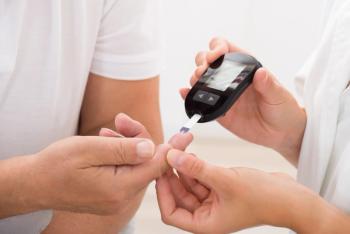
Early Glycemic Control Can Mitigate Cardiovascular Risk in Type 2 Diabetes
A retrospective analysis of more than 25k patients with type 2 diabetes details the impact achieving early glycemic control can have on the risk of cardiovascular disease events among these patients.
The old adage “time is of the essence” rings true when it comes to reducing cardiovascular risk among patients with type 2 diabetes, according to the results of a new study.
Results of the study demonstrate achieving ideal glycemic control within the first 12 months of diagnosis was associated with an improved prognosis when assessing risk of cardiovascular events among patients with type 2 diabetes, with those achieving glucose control in the first year reducing their risk of cardiovascular events by 25% while those who failed to address elevated HbA1c in the first 12 months experiencing a 21% increase in risk of cardiovascular events and those with the greatest HbA1c variability increasing their risk by 51%.
"The conventional wisdom has been to slowly and steadily treat type 2 diabetes with diet and medicine dose-escalation over years - the period over which it took people to reduce their sugar levels after diagnosis was thought less important for major vascular protection. However, our observational study suggests that getting blood levels under control quickly – within the first 12 months after diagnosis – will significantly help reduce cardiovascular events,” said study investigator Martin Whyte, BSc, PhD, a reader in Metabolic Medicine at the University of Surrey,
Citing data from the UK Prospective Diabetes Study that showed early glycemic control was associated with a reduction in macrovascular events, Whyte and team of colleagues sought to assess whether early glycemic control after a diagnosis of type 2 diabetes might reduce the risk of major adverse cardiovascular disease events.With this mind, investigators sought to conduct a retrospective cohort analysis of adults with type 2 diabetes from the University of Surrey’s Royal College of General Practitioners (RCGP) Research and Surveillance Centre (RSC) database, which contains primary care records from 1,595,170 people registered from 164 practices in England.
For inclusion in the investigators’ analyses, individuals needed to be newly diagnosed with type 2 diets on or after January 1, 2005, be aged at least 25 years or older at the time of diagnosis, and have HbA1c measurements at both diagnosis and after year 1 plus 5 or more measurements thereafter. For the purpose of analysis, 3 glycemic bands were created: group A, B, and C. These groups were defined as having HbA1c levels of less than 7.5%, 7.5-9.0%, and 9.0% or greater, respectively. Movement between bands from diagnosis to 1-year were used as exposures for the investigators’ analysis. The primary outcome of interest was the risk of major adverse cardiovascular events at 1-year post diagnosis, which investigators assessed using time-varying Cox proportional hazards models that included first-year transition and glycemic variability score.
Overall, 26,180 individuals were identified for inclusion. This cohort was 43.9% were female, had a median follow-up time of 1583 (IQR, 987-1737) days, a mean BMI of30.7±6.4 kg/m2, and, at the time of data extraction, a mean age of 68.7±12.6 years. Initial analysis indicated 48% of individuals began in band A and maintained that status, 16.1% improved from band C to band A, and 14.6% improved from band B to band A from diagnosis to 1-year. Investigators pointed out 7% of individuals began in band A but moved to band B or band C during the first 12 months.
Among the 26,180 patients included in the study, 4179 MACE events were recorded prior to diagnosis of type 2 diabetes and an additional 1457 events were identified in the first 12 months after diagnosis. Investigators also noted 2300 events occurred beyond the 1-year mark.
Compared to those who maintained band A status from baseline to 1-year, those who transitioned from band C to band A during the first year had a reduced risk of major adverse cardiovascular events (HR, 0.75 [95% CI, 0.60-0.94]; P=.014). In contrast, those who maintained band C status experienced an increase in risk of major adverse cardiovascular events (HR, 1.21 [95% CI, 0.81-1.81]; P=.34). When comparing risk based on glycemic variability score, results indicated those with the greatest levels of glycemic variability experienced an increase in risk of events (HR, 1.51 [95% CI, 1.11-2.06]; P=.0096).
“Our findings support the concept that effort must be made to achieve rapid metabolic normalization after the diagnosis of diabetes in those with a low propensity to hypoglycemia,” wrote investigators.
Reference
Whyte MB, Joy M, Hinton W, et al. Early and Ongoing Stable Glycaemic Control Is Associated with a Reduction in Major Adverse Cardiovascular Events in People with Type 2 Diabetes: A Primary Care Cohort Study. Diabetes Obes Metab. 2022 Apr 4. doi: 10.1111/dom.14705. Online ahead of print.
Newsletter
Pharmacy practice is always changing. Stay ahead of the curve with the Drug Topics newsletter and get the latest drug information, industry trends, and patient care tips.































































































































































